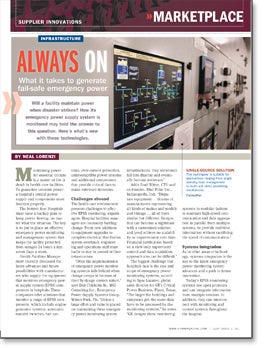Always on
 Maintaining power for essential circuits is a matter of life or death in health care facilities. To guarantee constant power, a hospital's critical power supply and components must function properly.
Maintaining power for essential circuits is a matter of life or death in health care facilities. To guarantee constant power, a hospital's critical power supply and components must function properly.
The bottom line: Hospitals must have a backup plan to keep power flowing, no matter what the situation. The key is to put in place an effective emergency power monitoring and management system that keeps the facility protected from outages 24 hours a day, seven days a week.
Health Facilities Management recently discussed the latest advances and future possibilities with manufacturers who supply the equipment that monitors emergency power supply system (EPSS) components in hospitals. These companies offer solutions that monitor a range of EPSS components, which include engine generator systems, automatic transfer switches, fuel systems, over-current protection, uninterruptible power systems and additional components that provide critical data to make informed decisions.
Challenges abound
The health care environment presents challenges to effective EPSS monitoring, experts agree. Hospital facilities managers are constantly battling change. From new additions to equipment upgrades to complete electrical distribution system overhauls, engineering and operations staff must battle to stay in control of their infrastructure.
"Often the implementation of emergency power monitoring systems falls behind when change creeps in because of their by-design custom nature," says Dan Chisholm Sr., MGI Consulting Inc., Emergency Power Supply Systems Group, Winter Park, Fla. "Unless a large effort and value is placed on maintaining these emergency power monitoring system infrastructures, they sometimes fall into disarray and eventually become irrelevant."
Adds Brad Witter, CTO and co-founder, Blue Pillar Inc., Indianapolis, Ind.: "Disparate equipment … dozens of manufacturers representing all kinds of makes and models and vintage … all of them similar but different. Integration can become a nightmare with a customized solution and [you] achieve no scalability or improvement over time. Financial justification based on a view-only supervisory control and data acquisition approach also can be difficult."
The biggest challenge that hospitals face is the size and scope of emergency power monitoring systems, according to Spas Lazarov, global sales director for GE's Critical Power Business, Plano, Texas. "The larger the buildings and campuses get, the more data have to be processed by the monitoring systems," he notes. "GE designs these monitoring systems in modular fashion to maintain high-speed communication and data aggregation in parallel from multiple systems, to provide real-time information without sacrificing the speed of communication."
Systems integration
As in other areas of technology, systems integration is the key to the latest emergency power monitoring system advances and a path to future innovation.
Today's EPSS monitoring systems use open protocols and can integrate information from multiple vendors. In addition, they can interconnect with monitoring and control systems throughout the hospital.
"Technology is being created to easily integrate campuswide power energy equipment inclusive of emergency power monitoring systems that allows what I have heard termed a Digital Energy Network: a digitally connected network of equipment that securely consolidates and centralizes the monitoring and management of an organization's disparate energy assets," Chisholm adds. "This can be done without complex engineering projects and hours of custom design; in fact, the latest platforms can be deployed in days or weeks."
Indeed, EPSS monitoring systems are no longer stand-alone solutions that only monitor emergency power systems; today's systems can interconnect with monitoring and control units throughout the hospital, according to Mike Nittoli, industry marketing manager, Eaton, Moon Township, Pa. "In addition, energy monitoring is coupled with engineering services necessary to design and implement an energy and data management solution across the enterprise."
Reaping the benefits
The latest emergency power monitoring systems offer hospitals reliability and cost-saving benefits, experts agree. Their primary function is to measure, record, report and verify that the EPSS system is operating, being properly maintained and is fully documented as required by the Authorities Having Jurisdiction policies. Thus, incorporating an effective monitoring system enhances the ability of an organization to conduct proper maintenance and testing of EPSS.
"By incorporating emergency power monitoring, our clients have been able to minimize unplanned outages, reduce staffing requirements during testing, shorten planning and development delays, and lower design costs by utilizing load profiling and balance reporting," says Jim Taufer, BEP, LEED GA, national business development manager, professional services, Schneider Electric, Palatine, Ill. "A monitoring system architecture can be an integrated design to share key performance information with authorized stakeholders to promote better decision-making and provide concise documentation of compliance."
The latest EPSS testing systems can help facilities managers enhance safety, reduce costs and expedite testing, according to Eaton's Nittoli. "With remote-control EPSS testing systems, personnel don't need to access live electrical equipment," he notes. "Tests can be initiated and completed from a single location. Software analyzes the data and immediately informs the operator if the EPSS has passed [the] tests."
Hospital facilities managers truly want real-time emergency power monitoring and the ability to automate the Joint Commission reporting process, say experts. "Many health care clients desire emergency power monitoring to incorporate energy efficiency and infrastructure utilization as part of the performance metrics as well as reliability measures for the emergency power system," says Schneider Electric's Taufer. "An emergency power monitoring system that can analyze and report on three key functions — energy efficiency, utilization and reliability — is extremely valuable in today's environment."
Developing strategies
A comprehensive emergency power monitoring system can analyze and report energy efficiency, infrastructure utilization and power system reliability as well.
This allows facilities managers to develop improved energy strategies and verify measures to prove that they actually work. Other utilities — water, air, gas, electric, steam (commonly referred to as WAGES metering) — also can be monitored through an integrated system.
"By incorporating WAGES metering, clients can identify the energy performance of key building systems such as heating, cooling, ventilation and lighting," Taufer adds. "By better understanding the consumption of energy throughout their buildings, they can better manage utility charges and improve energy efficiency."
GE's monitoring system provides the capability to use energy assets (e.g., diesel or natural gas generators) to parallel with the utility service provider to "peak shave" or export their excess capacity to the utility grid without sacrificing the critical load in the hospital as their first priority, says GE's Lazarov.
Interfacing with BAS
The latest emergency power monitoring systems can interface with building automation systems via industry standard communication interfaces such as BACNet, Modbus TCP, Modbus RTU, OPC and OPC UA. For example, Blue Pillar's system is server-based so the interface is provided via communication drivers for the various communication protocols.
What's more, hospitals have moved toward an integrated monitoring solution that typically is divided into two categories: building automation systems and emergency power management, says Lazarov. "Building automation systems enable centralized control of HVAC and lighting as well as optimization for energy efficiency. Emergency power management usually is kept as a separate system for reliability and load management purposes."
Eaton's EPSS monitoring system can be queried real-time using a variety of open protocols and methods, according to Nittoli. In addition, trended data is stored in a server database."We provide several types of monitoring systems, including systems built directly into the paralleling switchgear, systems built into energy monitoring software and custom systems built to arbitrary spec. Each can be provided with user-specified integration to existing [automation]."
Schneider Electric offers cloud-based as well as client-operated monitoring solutions. Both are Web-based interfaces. The benefits of a cloud-based system include reduced server hardware and software license expenses, according to Taufer. However, for critical emergency power monitoring, the "defend in place" approach typically leads clients to keep the monitoring server in-house because system reliability, real-time information and compliance documentation are the primary drivers.
"A hybrid approach is also possible with both a local monitoring server for the EPSS and cloud-based services to manage energy assets using information from building systems," Taufer adds. "This approach can help balance the needs and budgets of both the energy manager and the compliance manager."
EPSS partners
Caterpillar and Emerson offer components that interface with systemwide EPSS monitoring systems. Cat generator sets are equipped with control panels that can be accessed remotely, according to Don Dentino, market development consultant. "Cat Switchgear can be supplied with a 'data concentrator,' which allows for one-point integration with other monitoring systems," he says. "Generator set information, along with automatic transfer switch and uninterruptible power supply (UPS) operational information (i.e., metering, alarm status), can then be pulled from that one central location to interface with the systemwide monitoring system."
Emerson Network Power's ASCO Business, Florham Park, N.J., supplies equipment that monitors emergency generators, distribution and/or service entrance breakers, transfer switches, load banks, fuel systems, power meters, bus bars, generator paralleling controls, UPS and other devices within a systemwide EPSS. Metering is becoming a bigger portion of EPSS monitoring as a way to drive energy efficiency, according to Bhavesh Patel, director of marketing and customer support.
Patel says standard modules are being developed to replace current methods of one-off customization for speed of deployment.
"These standard modules can be configured for each application to allow a customized view of a facility while keeping the back-end processing standardized," he notes. "Also, new metering technologies that have built-in time synchronization — as well as network fault tolerance — are being developed to allow for easier processing of volumes of data generated in the digital health care world."
Regarding the future of digital energy networks, which consolidate and centralize the monitoring and management of energy assets, Witter of Blue Pillar predicts, "If the transition to financial viability is made for customers wishing to deploy a digital energy network, we will see dramatic growth in this marketplace. However, we will also need to establish a methodology for customers with aging equipment to justify upgrades, replacement and maintenance not only to protect the life of the equipment, but to maximize financial benefits to the organization."
Neal Lorenzi is a freelance writer based in Mundelein, Ill., and a regular contributor to Health Facilities Management.
| Sidebar - For more information |
| For further details on the emergency power monitoring systems discussed in this month's "Marketplace" article, readers can contact the following vendors: »Blue Pillar Inc. »Caterpillar »Eaton »Emerson Network Power's ASCO Business »GE Critical Power Business »Schneider Electric |




